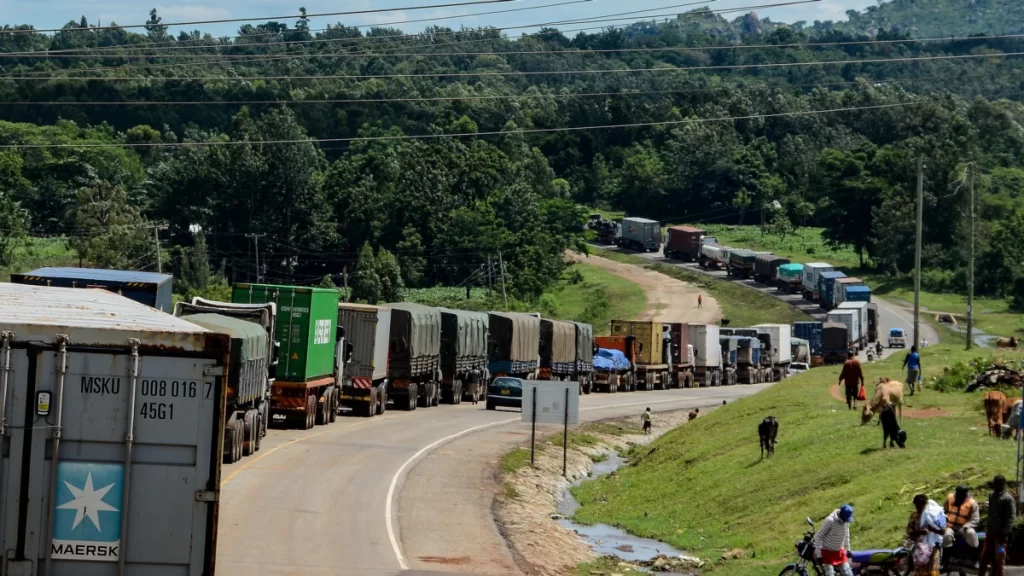
Kenya and Uganda face fresh logistical, bureaucratic and infrastructural challenges that are further obstructing the smooth flow of cargo on the Malaba and Busia borders.
This is despite the two countries signing bilateral agreements to ease traffic snarl-ups by trucks that are hindering trade between them.
Unilateral bans on products, high fees by Agriculture and Food Authority-Kenya, trade information asymmetry and single lane roads on the Kenya side stifle cross border business between Kenya and Uganda via Malaba and Busia One-Stop Border Posts.
The private sector including the transporters, importers, exporters, cross-border traders, Customs, immigration and other trade facilitation agencies on both sides of Uganda and Kenya, have raised alarm that emergence of new Non-Tariff Barriers (NTBs) is stifling cross-border trade.
This has resulted in the decline of intra-EAC trade from 21 percent in 2015 to 14 percent in 2021 according to the private sector players in the East African Community.
“The recent traffic jam at the Malaba border stretched for about 80 km inside Kenya. The reason this happened was due to introduction of new measures related to the control and prevention of Covid-19 by the Ugandan government,” said John Kalisa, CEO, East African Business Council.
He added, “The decline of intra-EAC trade from 21 percent in 2015 to 14 percent is attributable to NTBs. Future solutions to NTBs should be derived without waiting for ministerial and head of state decisions.”
Ministerial orders
Two weeks ago, Uganda introduced a Covid-19 fee at $30 for truck drivers leading to a strike that paralysed movement of trucks to Uganda for almost a week.
These led to a backlog of 4,000 trucks in a traffic queue of more than 80 km on the Kenyan Nairobi-Eldoret-Malaba-Kampala Northern Corridor major highway.
It prompted empty and small trucks, including those carrying perishable goods to be diverted to the Lwakhakha-Kenya-Uganda border to ease congestion.
Even then, it took the intervention of Kenya’s Transport Minister James Macharia and his Ugandan counterpart of Transport and Works, Minister Katumba Wamala to ease the traffic snarl ups.
“The traffic queue has been reduced from 40 km to 25 km. The backlog of 4,000 trucks has been reduced to 2,500 trucks,” said Abel Kagumire, Commissioner of Customs, Eastern Region, Uganda Revenue Authority (URA).
According to John Changole, Manager of Customs, Kenya Revenue Authority (KRA) at Malaba OSBP Kenya, 80 percent of cargo destined to Uganda, Rwanda, Burundi, Democratic Republic of Congo and South Sudan from the port of Mombasa pass via the Malaba OSBP.
“On average the Malaba OSBP clears 1,500 trucks per day. But due to Covid-19 testing requirements, we have been able to clear about 1,000 trucks,” said Changole.
Introduction of fresh NTBs including Covid-19 measures, fresh cargo inspection as opposed to use of Regional Electronic Cargo and Truck Drivers Systems (RECDTS), failure to make use of the regional bonding system among other challenges continues to slow the flow of goods and services to the border beyond Kenya. “As EABC we are concerned that the tools that are in place and are supposed to be used in facilitating trade are not being put into use. Like the cargo tracking system is not in use. Why do you bring a scanner and put it far from the border post?’ said Kalisa.
He called for a borderless East Africa for free flow of cargo.
“EAC is under a single Customs territory. In order to decongest our borders, let’s fast-track clearance of goods at the port of entry at Mombasa then allow the cargo to move seamlessly without again being subjected to the border checks. Because that is a double check and increases the cost of doing business in the region,” said the EABC CEO.
Tit-for-tat bans
Trade wars between Kenya and Uganda that saw unilateral bans on products such as maize, milk and poultry importation by Kenya has contributed to slow movement of goods at the Malaba and Busia borders.
Traders decried the impounding of fish from Kenya destined to the DR Congo worth Ksh40 million ($380,000) in October 2021 by Uganda and import ban on eggs and sugar by Kenya.
“Covid-19 restrictions on lockdown collapsed businesses for small-scale cross-border traders. We call for the removal of product bans such as sugarcane and eggs as these are commonly traded goods under the EAC Simplified Trade Regime,” said Mariam Babu, chairperson of Busia Women Cross-Border Traders – Uganda.
Kenya International Freight and Warehousing Association (Kifwa) are concerned about the safety of truck drivers.
“There are no police deployed to protect drivers and cargo despite the long queue of trucks. A vaccination station for drivers, sanitation facilities and other social amenities should be set up for drivers at the border,” said Kennedy Osiya, chairperson of Kifwa.
Further the storage and parking space for the cargo is wanting at border posts.
Leaders of clearing and forwarding associations want exemption of Customs rent on imported bulk products exceeding 21 days at the port of Mombasa.
Traders want a review of the information systems at the border to allow access to information that would enable cross-border traders make sound decisions. “There is a need for more support to modernise the trade information desk to enable traders to access information on currency rates, most selling products for the season such as foods, and information on new regulations among other data,” said David Erulu, chairperson of Busia Cross-Border Association, adding that these will allow for smooth trade at the border with Uganda